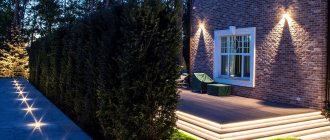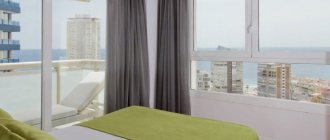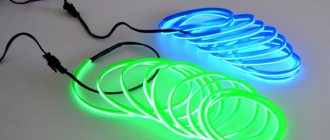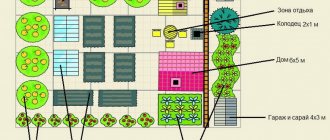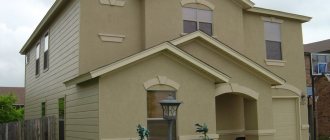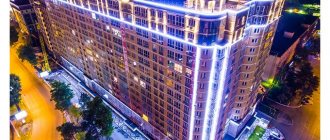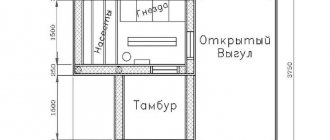Decorative lighting of a country house in the understanding of modern owners and designers is no longer a few light bulbs above the front door and at the gate, but a whole illumination system.
It is important to understand that it must be aesthetically attractive, functional, and technically well thought out.
Decorative lighting for a country house is not just decoration, it is a functional, technically and aesthetically thought-out system for orientation on the site. Light bulbs at the entrance to the house and above the gate are not decorative lighting. In order to create a unique and functional illumination, it is necessary to develop its design, choose the right lamps, and invite a specialist to form and connect it.
What is decorative lighting for a country house?
This design method is an opportunity to decorate the local area of a suburban area, buildings and plantings on it - flower beds, fruit plants and shrubs, ponds, and bring all this to a unique aesthetic system.
Today, this technique (methodology) in landscape design is very popular. With its help, you can hide shortcomings and emphasize advantages, focus on the house itself, and point out what else the owner wants to show off to guests or neighbors.
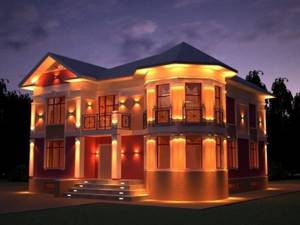
It is impossible to create lighting decorations by simply hanging light bulbs or lamps on the facade of a country house. The project must be handled by a specialist, as well as the technical work within its framework.
The project must take into account many aspects - from the power of the electrical network on the branch to which the country house is connected to the financial situation of its owner. Decorative lighting is a rather expensive decoration, especially if the lamps are chosen incorrectly.
Squares and streets

Roads and squares are illuminated in accordance with the developed scheme, which ensures safe movement. In addition, the lighting solution for these objects should be combined with the night lighting of other areas of the city. On holidays, the avenues and adjacent streets are decorated with bright illuminations.
Basic principles of decorative lighting for a country house
The illumination of the façade of a country house and a house adjoining (garden) plot can be multi-colored and “mono”, formed from the same type of devices and lanterns, lamps with different types of housings, lampshades, and light bulbs. Whatever style is chosen, it is important to adhere to the basic principles recommended by designers:
- adherence to a unified style,
- illumination must be complete,
- the effect of “light spots” on the site must be avoided,
- facade lamps are installed both inside and outside the house,
- the light of the devices is directed towards the walls, and not away from them,
- the system must be equipped with a functionality control relay.

Only illumination of the facade of the house will look too bright and vulgar. Around the garden plot, designers recommend placing several “branches” that are less bright than the lighting of the main building on the territory.
Garlands and spotlights can be used as additional sources of illumination in the local area. Garlands should be a continuation of the decorative lighting of the house, and spotlights or lanterns should complement it. They are installed in such a way that the streams of light form a continuous system.
How to choose lamps for decorative lighting of the facade of a house
First of all, lamps should be safe, not beautiful or cheap - this is very important to understand. The choice begins when a project for decorative lighting of a country house and its surrounding area and neighboring buildings has been created.
The choice is based on the safety of the devices and their compliance with the power of the electrical networks. Both the wiring used to install the lighting system and the lamps must be equipped with protective elements - shutdown relays in case of power failures or fire, insulation of elements and connections with a protection level of at least IP44. You can purchase such devices, wiring and components only in specialized trade pavilions.
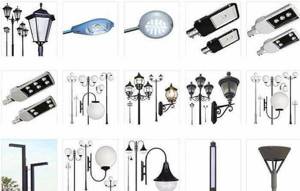
The modern market for lighting fixtures for decorative purposes offers a huge selection. If you are not absolutely sure that you will be able to make the right choice yourself, it is better to go shopping with the designer who developed the project. Most of the specialists in this field also have knowledge in the electrical field. They will be able to evaluate the effectiveness of lamps or lanterns, their safety and the degree to which they comply with the nuances of the project.
Autonomy of street lighting
An important factor will be the autonomy of the equipment, because it determines the efficiency of its operation. Of course, you can install ordinary lamps that can be activated using a button, but this is no longer relevant. If you try to keep up with the times, then you should give preference to more modern lamps, for example, devices with a motion sensor are especially popular. You can also purchase models that respond to sound, have touch sensors or lamps with a smart home system.

In addition, when purchasing lighting fixtures, you need to pay attention to their functionality, because they must have at least 3 modes: dim, medium and bright. However, in order to choose the right lamps for outdoor lighting, you need to determine their type. According to their purpose, they are divided into night and daylight devices. The former will illuminate paths and especially important areas of the adjacent territory, the latter will perform a decorative function.
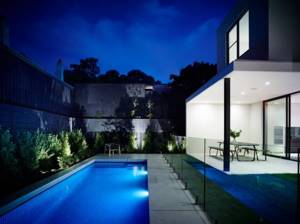
Zoning space for decorative lighting of a country house
When creating a decorative lighting system for a country house and plot, it is very important to correctly zone the space. An individual light supply technique is developed for each zone.
Designers use the following principle of zoning outdoor decorative lighting - lighting for:
- Houses,
- neighboring buildings,
- paths and gates,
- garden and green spaces.
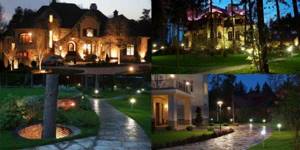
This stage of creating a decorative lighting project is one of the most difficult. Buildings can be concentrated in one place or scattered around the site, for example, a gazebo is located deep in the garden, and paths, as a rule, diverge in different directions.
Green spaces are divided into several more zones - flower beds, shrubs and trees. It is not recommended to highlight them with bright light streams, but they must be marked and highlighted on the site.
How to pay less for site lighting
Landscape lighting for a country house consumes a lot of electricity. Evening decor should not only be beautiful and useful, but also inexpensive. Budget incandescent bulbs often burn out and use a lot of energy. To save money, you need to find a less expensive option.
LED lamps and strips have high efficiency and an affordable price. The bright shine comes in white and yellow colors. The wave intensity of some models can be adjusted manually. Low electricity consumption and long service life will justify the money spent.
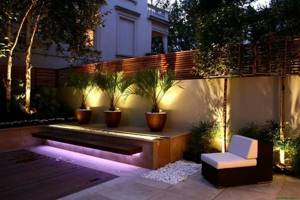
Garden plot Source 9dach.ru
Fluorescent and halogen lamps are suitable for decorative lighting of a country house. Fiber optic systems have appeared recently, but they allow you to implement bold design solutions in your summer cottage. The devices are used for operation near landscape elements that are prohibited from high temperatures. If you have a generator, you can provide light to a large area.
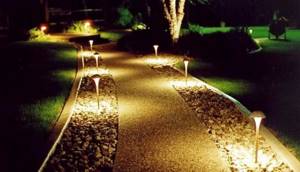
Landscape lighting Source landscape-a.com
Electric lamps are most often used to decorate the area of a country house. To install the devices, preparatory work is needed. The cable at the dacha is hidden in a pipe or corrugation, after which they begin to install the models. Solutions come in different shapes and forms.
Solar-powered options are used for spot lighting of individual landscape areas. During the day, the devices accumulate energy, and in the evening they emit soft, warm light. The battery charges even in cloudy weather. The components are not tied to a location and can be moved around the territory.
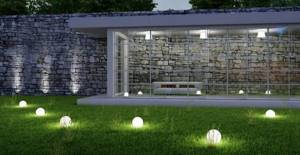
Decorative functional balls according to the area Source www.o-svet.ru
Decorative lighting of buildings in a suburban area - principles and rules
The illumination of a house and other buildings can be very diverse. It can be formed from LED strips, bright lanterns or hidden lamps. The direction of their light flows depends on what needs to be emphasized on the façade and what is best hidden. Some design techniques allow you to make mistakes or flaws when decorating the facade with their advantages.
For example, by directing the flow of light across minor irregularities, you can create an original decorative effect, and the synchronous change of light and shadow looks great on stepped stone or brickwork. A constant, even stream of soft light from below is suitable for smooth, monochromatic brickwork.
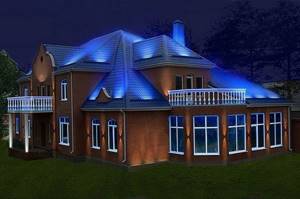
Decorative lighting of secondary buildings - gazebos, barbecue areas, ponds and other small objects - looks original in a suburban area. Only one rule must be followed - it should not be brighter than the lighting of the house itself. For them, it is better to choose compact lamps or diode strips in a single color scheme, without flickering effect, and place them along the contour of the building.
Should a fence (enclosure) be made part of the decorative lighting of a suburban area? Many designers agree that it looks vulgar. Illuminate, mark with lamps or lanterns, it is better to just enter the territory.
Staircase lighting
First of all, lighting of stairs is necessary for your safety, so you should pay special attention to their lighting. If the task of decorating the staircase space with the help of lamps is being solved, then ground lamps installed on special racks can play a huge role here. Such lamps will decorate the staircase even during the day, when there is no need for lighting. The lamps can also be mounted directly into the steps.
Don't forget the switches. In this case, it is better to use a special ladder switch instead of the usual one. It will allow you to turn on the lights downstairs and turn them off upstairs at the other end of the stairs.
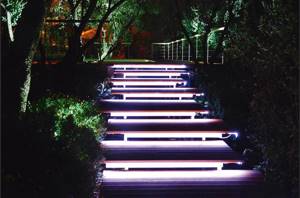
Decorative lighting of paths and green spaces in a suburban area
Lighting paths in a suburban area is more a necessity, providing comfort, than decoration. It should be of medium brightness, not harsh on the eyes, but only indicating the contours of the object, allowing you to walk through the yard without problems.
Lamps, as a rule, are placed at the level of the ground, flooring or slightly higher - a maximum of 30 cm. It is better to give preference to devices with adjustable direction of the light flux. Tall lights are suitable for these purposes if the path is wider than 1 meter.
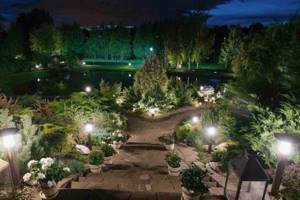
Decorative lighting for flower clusters, shrubs and compact trees looks very original in a suburban area. It is better to “hide” devices (lamps) under foliage so that their light is scattered and refracted, creating “living” streams.
Decorative lighting of a country house is a complex system, and it must be formed and installed by professionals. And this is a requirement for safety, not aesthetics.
Types of light sources
In addition to lighting standards, overall dimensions and style of poles, important parameters of street lighting systems include operational safety and the level of electricity consumption. To eliminate emergency situations, it is necessary to ensure that light sources are sealed and protected from overheating, and grounding will help to avoid accidents.
To increase the efficiency of systems, it is necessary to correctly select the power of lighting equipment and the type of light sources. The most popular are:
- Sodium. They create a luminous flux of the warm yellow spectrum and have good color rendering. Such lamps help save energy, but are not resistant to sudden changes in temperature, so they must have bulbs made of special glass.
- Metal halide. They are high-pressure light sources, provide good visibility and are in demand at sports facilities.
- LED. Such lamps have a high color rendering index, a long service life and retain their functions even with significant temperature changes. Such light sources do not heat up and are resistant to voltage surges, and a variety of colors allows you to create interesting effects.
An automatic system for controlling street lighting allows you to optimize energy consumption. It is equipped with ESA devices for remote monitoring. The use of such systems increases the level of security, provides the possibility of centralized control and reduces maintenance costs.
Important! When organizing street lighting systems, it is necessary to pay attention to light pollution, which negatively affects flora, fauna and human well-being. To minimize the consequences, it is necessary to comply with lighting standards, ensure that some devices are turned off after midnight, and prevent light from shining on foreign objects. In addition, it is advisable to use lanterns with reflectors that direct the light flux downward.
